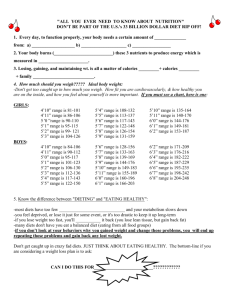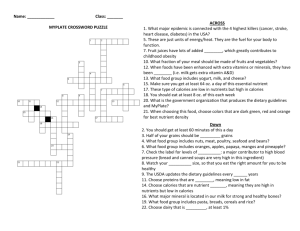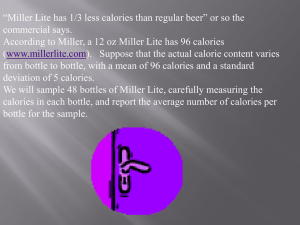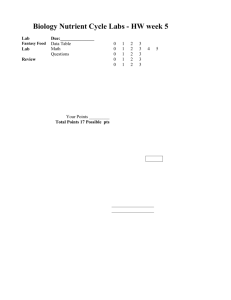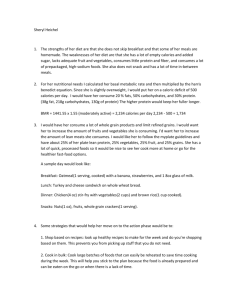LECTURE 23 HUMAN USE OF SUN`S ENERGY
advertisement
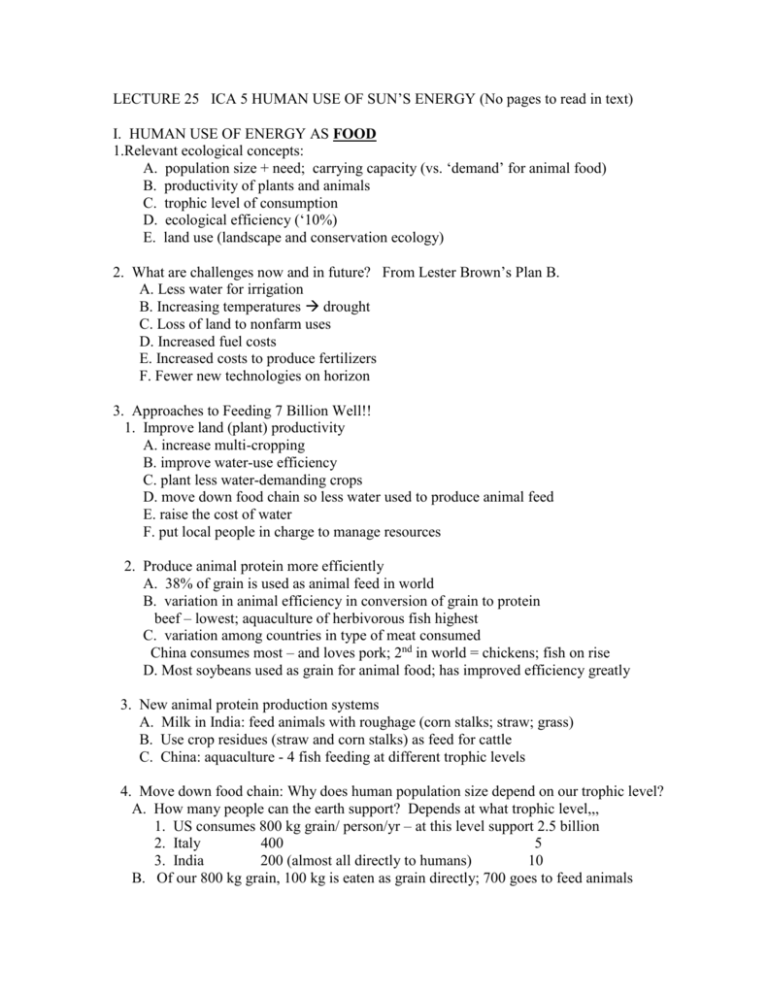
LECTURE 25 ICA 5 HUMAN USE OF SUN’S ENERGY (No pages to read in text) I. HUMAN USE OF ENERGY AS FOOD 1.Relevant ecological concepts: A. population size + need; carrying capacity (vs. ‘demand’ for animal food) B. productivity of plants and animals C. trophic level of consumption D. ecological efficiency (‘10%) E. land use (landscape and conservation ecology) 2. What are challenges now and in future? From Lester Brown’s Plan B. A. Less water for irrigation B. Increasing temperatures drought C. Loss of land to nonfarm uses D. Increased fuel costs E. Increased costs to produce fertilizers F. Fewer new technologies on horizon 3. Approaches to Feeding 7 Billion Well!! 1. Improve land (plant) productivity A. increase multi-cropping B. improve water-use efficiency C. plant less water-demanding crops D. move down food chain so less water used to produce animal feed E. raise the cost of water F. put local people in charge to manage resources 2. Produce animal protein more efficiently A. 38% of grain is used as animal feed in world B. variation in animal efficiency in conversion of grain to protein beef – lowest; aquaculture of herbivorous fish highest C. variation among countries in type of meat consumed China consumes most – and loves pork; 2nd in world = chickens; fish on rise D. Most soybeans used as grain for animal food; has improved efficiency greatly 3. New animal protein production systems A. Milk in India: feed animals with roughage (corn stalks; straw; grass) B. Use crop residues (straw and corn stalks) as feed for cattle C. China: aquaculture - 4 fish feeding at different trophic levels 4. Move down food chain: Why does human population size depend on our trophic level? A. How many people can the earth support? Depends at what trophic level,,, 1. US consumes 800 kg grain/ person/yr – at this level support 2.5 billion 2. Italy 400 5 3. India 200 (almost all directly to humans) 10 B. Of our 800 kg grain, 100 kg is eaten as grain directly; 700 goes to feed animals C. Complete this table to understand the concept of eating lower on the food chain: DIET of 2000 calories Calorie Source # Calories Consumed 1. 100% Plant Plant 2000 0% Animal Animal XXXX 2. 90% Plant Plant 1800 10% Animal Animal 200 3. 70% Plant Plant 1400 30% Animal Animal 600 4. 50% Plant Plant 1000 50% Animal Animal 1000 5. 0% Plant Plant XXXX 100% Animal Animal 2000 * Assume 10% Ecological Efficiency Ecologically Equivalent Calories* 2000 XXXX 1800 2000 1400 6000 1000 10000 XXXX 20000 Total Ecologically Equivalent Calories 2000 XXXX XXXX 3800 XXXX 7400 XXXX 11000 XXXX 20000 5. The Hungry Planet (Peter Menzel and Faith D’Aluisio) Item Range USA $ spent on food $1 to $500 /week calories in diet 2114 (Darfur) to 3774 (28% from animal products) sugar used almost none to 158 pounds/year) obesity levels 1% (China/Japan) 27% meat consumption 7 in Bhutan 275 pounds/year 6. Calculate your daily required calories: Height (in) ____________ Activity level ____________ BMI _______________ Weight (lb) ____________ Calories if 30 yr _______ Calories for my age_____ 7. Assignment: bring to class on Thursday: A. Keep track of everything you eat for 24 hr. B. Use: U of I’s Nutrition Analysis Tool 2.0: http:www.nat.illinois.edu/mainnat.html C. Figure out and write on piece of paper (show steps 1-3 below): 1) calories consumed from plants; from animals; total calories 2) % of total calories from animal sources 3) calculate amount of ecologically equivalent calories consumed relative to a vegetarian e.g. total calories = 2100; plant calories = 1449 = ecological equivalent plant calories animal calories = 651; (651 x 10) = 6510 = ecological equivalent animal calories total ecologically equivalent calories = 7959 My diet/vegetarian diet = 7959/2100 = 3.8 X more ecologically equivalent calories than vegetarian II. HUMAN USE OF ENERGY FOR FUEL 1. Relevant ecological topics: A. Sun: origin of (almost) all energy that humans use B. Ecosystem = energy-transforming machine C. Primary Production sets limits on energy fixed by biosphere D. Photosynthesis: sun energy transferred to chemical bond energy E. Respiration (or burning): Release (and transfer) of chemical bond energy; generation of ATP + heat Aerobic Anaerobic: less release as energy F. Incomplete decomposition: accumulate biomass + energy PAST: storage of chemical bond energy 2. Scenario: Accumulation of chemical bond energy from past photosynthesis A. Production > consumption B. Death, then decomposer food chain C. Bury by sediments – decomposition slowed and incomplete D. Biomass accumulates E. Organic matter transformed to ‘fossil’ fuels 3. What physical transformations of organic matter led to fossilized biomass? When: Carboniferous = Devonian, Mississippian, Pennsylvanian 3-4 million yrs ago! Where: Ocean What happened: Algae (diatoms) sedimentation decomposition by bacteria/protists pressure/heat (Crude) oil + natural gas (hydrocarbons) Where: Land What happened: Woody plants in swamps biogas via anaerobic respiration by bacteria Incomplete decomposition peat ( a fuel) Sedimentation Pressure + heat transformed wood fragments thermogenic natural gas leaves and wood oil + coal If anaerobic S in coal Trapped by overlying sediments Retrieval by drilling/strip mining/digging 4. Chemical transformation of organic matter Starting compounds: Lipids, proteins, carbos, lignin, cellulose in biomass Kerogens (mix of complex heavy hydrocarbons) Heat Lighter hydrocarbons by breaking bonds of kerogens 5. PRESENT: break fossilized chemical bonds A. What are major uses of fossil fuels? Which fuel is used for which use? 1. heat oil, coal, gas 2. machines oil, gas 3. electricity oil, coal B. What is the relation of gasoline to oil? gasoline is one of many products derived from distillation of oil C. What is the relation of electricity to fossilized fuels? use coal, oil steam, wind turn turbines wrapped in copper and with magnets strip electrons from copper flow of electrons 6. What are your sources of electricity and their relative importance? Put a * by each with fossilized sun’s energy. A. coal * = 2 B. oil * = 1 C. natural gas * = 3 D. nuclear = 4 E. renewables * = 5 7. How do the various sources differ in ‘cleanliness’? (= amount of CO2/SO4 produced) (much SO4 from some coal) Coal: 1200 g CO2/kw/h electricity Oil: 900 Gas: 750 Renewables: < 50 8. Development is ‘sustainable’ if it “meets the needs of the present without compromising the ability of future generations to meet their own needs.” How realistic is ‘intergenerational equity’, if we are rapidly exhausting resources? Case 1: Renewable Resources A. If annual depletion rate > annual growth rate, then over-harvesting (forests, fisheries, wildlife) will decrease amount for future generations. If present-day usage < annual increase in stock enough for future generations only if non-positive human population growth. If population is growing, then current depletion must be <annual increase (to allow stock to grow over time). Holding current consumption to be < annual increase lowers well-being of present generation. So how much will we sacrifice our standard of living for those born 100 or 1000 in future? What is relative importantce of renewable sources of energy? Put a * if it depends on sun’s energy. A. 5 = *Solar heat and electricity B. 3 = *Wind electricity C. 2 = Hydropower electricity D. 4 = Geothermal heat, electricity E. 1 = *Biofuels machines Seed ethanol in gasoline Vegetable oil (from seed) biodiesel Crop residues (e.g. corn stalks) + Non-crop cellulose (e.g. switch grass + Miscanthus ethanol (see PPT on Biofuels on 203 lecture website) Case 2: Non-renewable Resources (e.g. oil) Speed of Depletion of Non-renewable Energy (stored 3-400 million years ago) When were they discovered and put to use? Coal: 1700s = Industrial Revolution Oil gas: 1859 in Titusville, PA Electricity: late 1800s (Edison) What is projected time of depletion? oil peak is now (or past in many countries) So use up in about 300 years! (2.5) – 3 trillion barrels recoverable oil in world today Global mean per individual per year = 5 barrels/yr –necessarily reduces amount for future USA “ “ “ “ “ = 25 barrels/yr How much oil should we be using to assure ‘intergenerational equity’ for 1000 years? Assume world population size = 10 billion (and stable) Annual world consumption per year = 50 billion Need how much for 1000 years = 50 trillion (…but we have only 3 trillion left…) At current world rate of consumption, how many years will it take to run out of oil? = 3 trillion / 50 billion = 33/5 = 60 years At current USA rate of consumption? = 5 x faster = 12 years To be equitable for 1000 years, we need to reduce to 3 billion /yr = we need to reduce global per capital consumption by 94% So…how sustainable are we? Are we deceiving ourselves?



